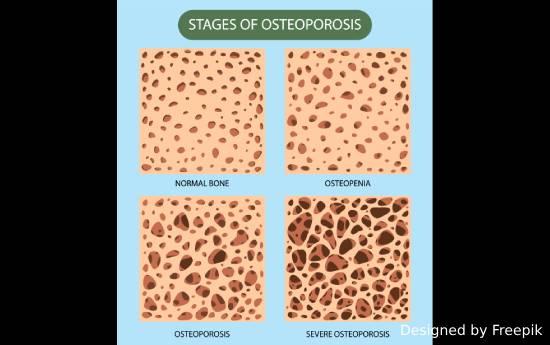
Osteoporosis, the “silent disease,” is a formidable foe, gradually weakening bone health and increasing the risk of debilitating fractures. As an orthopedic surgeon, I’ve witnessed firsthand the profound impact this condition can have on one’s independence and quality of life. But fear not, for we possess powerful tools to combat this silent bone thief – a blend of modern medical advances and ancient wisdom passed down through generations.
The Culprit Unveiled: Understanding Bone Loss
Our bones are living, dynamic tissues engaged in a constant cycle of breakdown and renewal called “remodeling.” In our youth, this process occurs efficiently, with new bone formation outpacing bone loss. However, as we age, this delicate balance shifts and bone loss can outpace new bone formation, leading to the insidious development of age-related osteoporosis. With the reduction in the bone mass, there is gradual deterioration of the bone health with resultant increased risk of osteoporotic fractures especially those of the hip and the vertebrae.
The Many Faces of Osteoporosis
Advancing age causes significant loss of bone health as well as muscle mass, a condition termed “Osteosarcopenia”. As a result, with age, the patient becomes increasingly frail and activities become restricted as the functional capacity reduces.
While age is a common culprit, osteoporosis can also arise secondary to various medical conditions and treatments. Endocrine disorders like hyperthyroidism, gastrointestinal diseases like Crohn’s, autoimmune conditions like rheumatoid arthritis, certain cancers and their treatments, organ transplants requiring bone-depleting medications, and chronic disorders like kidney disease – all these can disrupt the intricate mechanisms that maintain bone strength, contributing to the development of secondary osteoporosis.
While osteoporosis often goes unnoticed until a fracture occurs, we need not remain defenseless against this silent intruder. Modern diagnostic tools, like the non-invasive bone health scan (DEXA scan), can assess your bone health and allow for early intervention, before significant damage occurs.
FRAX
All patients who suffer from osteoporosis need evaluation of the risk of developing fractures and need to be managed accordingly. Various scientific tools exist to assess this risk. One of the most commonly used tool is the Fracture Risk Assessment tool acronym FRAX developed by the University of Sheffield (https://frax.shef.ac.uk/FRAX/tool.aspx?country=9). Other similar tools include Q-fracture (https://qfracture.org) also from the United Kingdom and the Garvan Fracture Risk Calculator from New Zealand (https://fractureriskcalculator.com.au/calculator/). Another simple risk assessment tool is the Osteoporosis Self-Assessment Tool for Asians (OSTA) developed at the Tan Tock Seng Hospital in Singapore. Incorporating the frail nature of osteoporotic patients the formula provided is: Age (Years) – Weight (Kilograms). They have categorised three risk groups as High risk (score >20), medium risk (score 0-20) and low risk (score <0). Those at high risk as assessed by these tools are recommended to undergo a DEXA scan.
Bone Mineral Density (BMD)
DEXA which stands for Dual Energy Xray Absorptiometry is a radiological test that measures the amount of bone per unit volume or per unit area. Two important sites are recommended for this assessment namely the lumbosacral spine and the proximal femur. The results are described as a T-Score or a Z-score. The T-score compares the patient’s bone health with the average value for a healthy young individual of the same sex. The Z-score compares the value with the average value for another person of the same age and gender as the patient.
Bone Turnover Markers
These are advanced investigations not routinely done for screening or diagnosis of senile osteoporosis. They are generally reserved for patients with secondary osteoporosis for identification, follow-up assessment or prognostication. Your treating doctor can guide you regarding the need, if any, for these investigations.
Fortifying Your Bone Health: A Multifaceted Approach
Combating osteoporosis, whether age-related or secondary, requires a comprehensive strategy, drawing upon the latest medical advancements and the time-honored practices of our ancestors.
Ancient Wisdom:
Our ancestors, though lacking modern medical knowledge, unwittingly practiced habits that fostered strong, resilient bones. Exposure to early morning sunlight provided vital vitamin D, while physically demanding lifestyles and plant-rich diets supplied essential bone health-building nutrients. Even traditional home remedies, like bone broths and herbal infusions, may have played a role in nourishing skeletal health.

General treatment measures:
- Diet and Nutrition: It is recommended to have a healthy dietary intake with increased intake of fruits, vegetables, fish, poultry and whole grains. In other words conventional natural foodstuff taken balanced proportions acts as a natural safeguard against weakening of musculoskeletal health. It is better to avoid processed meats, refined sugars, animal fat, fizzy soft drinks (“Western food”) as these are known to increase risk of osteoporosis. The important constituents of diet that can significantly influence bone health are calcium, vitamin D and protein intake.
- Calcium and Vitamin D supplementation: It is important to not totally depend upon calcium/vitamin D supplements but to complement these with dietary intake. The recommended dietary intake of calcium is between 800-1000 mg/day for healthy adults and upto 1200 mg/day for postmenopausal women and the aged. The recommended vitamin D intake is upto 300 IU/day with cholecalciferol being the preferred form of therapy. Consult your doctor upon which form of supplementation is best suited for you.
- Exercise: Regular activity promotes bone health. It is especially recommended to build bone mass from a young age as this reduces the risk of developing primary osteoporosis in later life. Frequent weight bearing exercises, resistance training, exercises that promote balance as well as aerobic exercises are advised. For those short of time, even something as simple as brisk walking for 30 minutes at least 4-5 times per week can promote health.
- Lifestyle modifications: Promotion of healthy lifestyle habits from childhood can greatly boost bone mass. Quitting smoking helps prevent reduction in bone mass. It may take upto 5 years after cessation of smoking for it to take effect. Similarly abstinence from alcohol can take upto 3-4 years for the bone health to start improving.
- Fall prevention: Even trivial falls can increase the risk of fractures. Elderly patients are often on other medications which can cause dizziness. They may have existing vision disturbances like cataract or existing balance issues due to neurological disorders. It is important to modify the household environment to help prevent falls. Some simple home safety interventions include
- Minimise clutter at home.
- Use of anti-skid mats or slip-resistant flooring tiles
- Anchor rugs / carpets
- Installation of handrails in commonly used spaces where the risk of falling is high such as bathroom, long stairway
- Ensure adequate lighting
Pharmacological measures:
From bisphosphonates that slow bone loss to modern drugs like denosumab and teriparatide that stimulate new bone formation, modern medicine offers a structured regimen to strengthen and protect your bone health. When secondary causes are identified, addressing the underlying condition becomes a crucial component of the treatment plan. Your healthcare provider will tailor a personalized regimen based on your unique needs and risk factors.
The Dos and Don’ts:
Dos:
– Calcium and vitamin D – essential building blocks for strong bone health
– Weight-bearing exercise – a potent stimulus for bone formation
– Quit smoking and limit alcohol – lifestyle choices that nurture bone health
– Consider medication – when lifestyle changes aren’t enough, discuss treatment options with your healthcare provider
– Embrace ancient wisdom – learn from the bone-strengthening practices of our ancestors
– Address underlying conditions – if secondary causes are present, managing them is key
Don’ts:
– Ignore risk factors – family history, age, and certain conditions increase vulnerability
– Neglect falls and fractures – these can be early warning signs
– Dismiss diet, exercise, and lifestyle – a trio essential for skeletal integrity
- Overlook secondary causes – many medical conditions can contribute to bone health loss
- Attempt to lift heavy weight in a forward or side bent posture.
Authoritative Guidelines on Osteoporosis
For comprehensive information and guidelines on osteoporosis prevention, diagnosis, and management, refer to the following reputable health authorities:
World Health Organization (WHO): (https://www.who.int/chp/topics/rheumatic/osteoporosis.pdf)
National Osteoporosis Foundation (USA): (https://www.nof.org/patients/what-is-osteoporosis/)
International Osteoporosis Foundation: (https://www.osteoporosis.foundation/)
National Institute for Health and Care Excellence (NICE) – UK: (https://www.nice.org.uk/guidance/ng146)
Indian Menopause Society: (https://www.indogsonline.com/osteoporosis-and-menopause)
These organizations provide evidence-based recommendations, educational resources, and support for healthcare professionals and patients alike in the battle against osteoporosis.
If you have concerns about osteoporosis or want to take proactive steps towards maintaining strong, resilient bones, schedule an appointment. Together, we’ll embark on a journey to outsmart the silent bone thief, ensuring you can live life to the fullest, unencumbered by the limitations of fragile bones.
Dr. Tushar Sandeep Kadam
*Disclaimer: This document is for information purposes only and does not substitute professional medical advice. Always consult with a healthcare provider for an accurate diagnosis and treatment plan.


